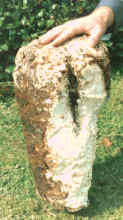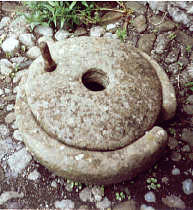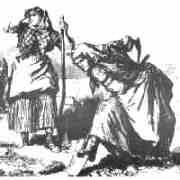
A sample of bog butter
with imprints of a wicker
container on the outside.

A rotary quern
for grinding corn
The traditional measure of wealth in rural Ireland was the cow and visitors to the country were fascinated by the Irish diet of bánbídh or 'white meats' which included sour milk (bainne clabair), curds and whey, buttermilk, butter and cheese. Women's work included milking cows, churning, cheese-making and producing bánbídh.
| I will not lead you to the baser cabins, where you shall have no drink but Bonyclabber, milk that is soured to the condition of buttermilk, nor no meat but mullagham (mallabanne), a kind of choke-daw cheese, and blue butter and no bread at your first coming in, but if you stay half an hour you shall have a cake of meal unboulted and mingled with butter baked on an iron called a griddle, like a pudding cake. Luke Gernon, A discourse of Ireland Anno 1620 quoted in C.Litton Falkiner, Illustrations of Irish history and topography, London, 1904, p. 359. |
| ... the people generally being the greatest lovers of milk I ever saw, which they eat and drink about twenty several sorts of ways and what is strangest, love it best when sourest. Robt. Murray, The Journal of John Stevens 1689-1691, quoted in Regina Sexton, A little history of Irish food, Dublin, 1998, p.96. |
Surplus butter was preserved by submersion in bogs and is occasionally found by people cutting turf. Some butter may have been buried in the peat for centuries. It would have changed colour and texture over the years.
|
A sample of bog butter |
A rotary quern |
Women ground oats in a quern, made flat oat cakes and baked them on a griddle to be eaten with large quantities of butter. By the nineteenth century many were producing soda bread using wheaten flour with bread soda as a raising agent.
Fish provided relish and variety and herbs such as watercress and nettles were eaten but kitchen gardens were not common. Near the seashore edible seaweeds included dulse and carrageen.
| Shamrocks, watercresses, roots and other herbs they feed upon, oatmeal and butter they cram together. They drink whey, milk and beef-broth, flesh they devour without bread, corn such as they have they keep for their horses. Edmund Campion, History of Ireland, 1633 quoted in C.Litton Falkiner, Illustrations of Irish history and topography, London, 1904, p. 314. |
People drew blood from living cattle and cooked it with milk or grain and they shared fresh meat with their neighbours whenever they slaughtered surplus animals.
Potatoes were introduced to Ireland about 1590 and from being a novelty at first, soon gained acceptance.
| The Irish poor were relying dangerously on potatoes as a staple food by about 1750 and the population was increasing at an alarming rate, but about 1778 Arthur Young studying Irish farming, remarked that the poor in Ireland looked healthier than those in England. He wondered whether potatoes were better than the bread and cheese of the English poor but had no doubt, 'that the milk of the Irishman is incomparably better than the small beer, gin or tea of the Englishman.' Eventually, millions of Irish cottiers were reduced to subsisting on an acre of potatoes, together with a cow and a pig or two. The family lived on cow's milk and potatoes and they fed extra potatoes to the pig which was sold to pay the rent. A second pig, if they could afford it, could be killed and salted to provide bacon for the family. |
 Digging potatoes
|
While observers in early modern times agreed about the vast amounts of milk consumed by the rural Irish, they disagreed about the consumption of alcoholic drinks. Taverns, selling French and Spanish wines could be found in cities and large towns while women seem to have dominated the brewing and sale of ale at times.
Taverns were not common in Gaelic areas, though many women brewed ale at home and alcoholic drinks were offered by the 'woman of the house' as a feature of hospitality in Gaelic homes. The rural population held celebrations outdoors at venues such as hills, wells and woods but they frequented taverns and shebeens (illicit drink shops) and sometimes got drunk when they attended fairs and markets in local towns. The following extract from Fynes Moryson, a hostile witness who wrote about his travels in Ireland 1609-1625, is likely to be exaggerated.
| Neither have they ['the wild Irish'] any beer made of malt and hops, nor yet any ale - no, not the chief lords, except it be very rarely; but they drink milk like nectar, warmed with a stone first cast into the fire, or else beef-broth mingled with milk. But when they come to any market town to sell a cow or a horse, they never return home till they have drunk the price in Spanish wine (which they call the King of Spain's daughter) or in Irish usquebagh, and till they have outslept two or three days' drunkenness. Quoted in J.S. Donnelly & Kerby A. Miller (eds.), Irish popular culture 1650-1850, Dublin, 1999, p.58. |
Arthur Young, a more objective witness, noted in 1778:
| An Irishman loves whisky as well as an Englishman does strong beer, but he cannot go on Saturday night to the whisky house and drink out the week's support of himself, his wife and his children, not uncommon in the ale house of the Englishman. Arthur Young, A tour in Ireland, 1776-8, reprinted Cambridge, 1925, p.184. |
Various attempts were made from time to time to control aspects of the drink trade. For instance, English authorities became alarmed at the gradual spread of public houses to Irish rural areas. They saw them as dangerous places where rebels and traitors could meet and plot against the government and they tried in several ways to control them by licences.
Local authorities sometimes issued regulations forbidding women to serve or to purchase alcoholic drinks and the Irish pub came to be a space generally reserved for males until about the 1960s.
| In 1565 the Dublin corporation when fixing the price of ale, passed a resolution forbidding the sale of ale to unmarried women ... Elizabeth Malcolm, 'The rise of the pub' in J.S. Donnelly & Kerby A. Miller (eds.), Irish popular culture 1650-1850, Dublin, 1999, p.56. |